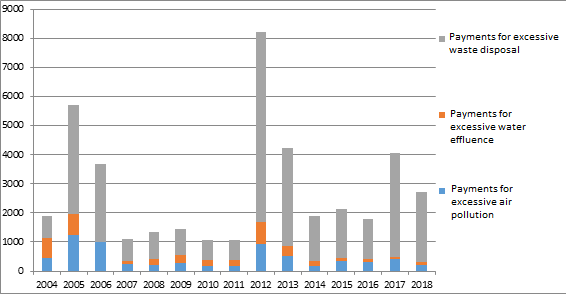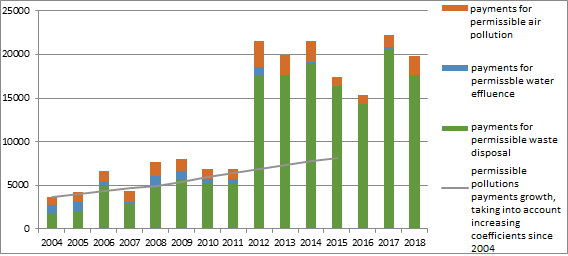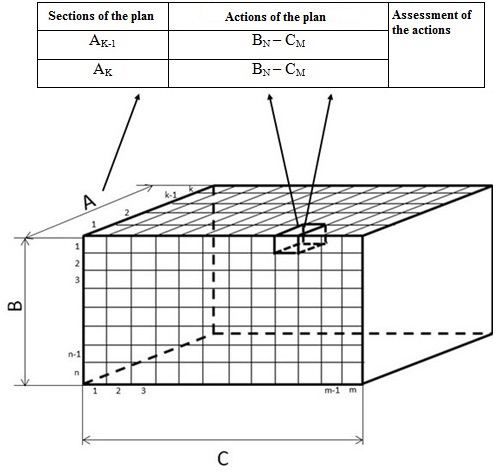Abstract
Economic activity of people leads to the destruction of environment and its irreversible changes; reduces biodiversity, impairs the living conditions of people. Major pollutants are enterprises which concern with their own profit and “pay off” the social and environmental damage by excessive and permissible emissions payments. This approach to organization of enterprises environmental activity is not conducive to sustainable development of environment and leads to ecological and social negative consequences. Moreover, it is not efficient for the enterprises which are forced to increase prices of goods due to rising environmental payments. If enterprises have excessive emissions then pressure on the environment exceeds limits. In this case the enterprises have unproductive costs and lose profit. Solving of the problem of environmental safety and social responsibility of the activity of enterprises requires new approaches to management. The suggested approach to planning of production activity allows ensuring the safe environment and public interests satisfaction. In addition, the enterprises would be able to reduce their unproductive costs. The correlation matrix of ecological and economic indicators was compiled on the basis of the analysis. The analysis allowed developing the morphological model of planning, the indicator and the criterion of assessment of ecological and economic effect and efficiency of planned organizational and technical actions. They were developed, taking into account risks of planning and inflation in different time periods. In addition, the authors of the article suggested the algorithm that allows including in plans of enterprises only socially oriented, environmentally safe and economically efficient actions.
Keywords: Planningprocessanalysismodelindicatoralgorithm
Introduction
Nowadays the interests of society are contrary to interests of enterprises. This requires improvement of management processes of the environmental system in these enterprises. It relates to different fields of economy, including transport enterprises. One of the areas of improvement of social and environmental safety, economic performance of production processes in transport enterprises is a new environmental approach to the planning of organizational and technical actions. This approach is intended to ensure interrelation of social and commercial interests, as well as to create an environment that would be safe for nature and people. The approach does not allow including unsafe and inefficient planned actions to the transport enterprises’ plans. As a result, the society receive decrease of pollutions, environmental improvement. It supports profitability of the enterprise by rationalizing of economic activity and unproductive costs reduction. That is why development of methodological support of planning of socially oriented, environmentally safe and economically efficient organizational and technical actions in railway transport enterprises is relevant in this scientific article.
Problem Statement
Indicators of transport enterprises activity are considered in the article on the example of the railway transport and its enterprises. The represented indicators reflect disastrous social and environmental consequences of activity of such enterprises, as well as their unproductive costs as payments for excessive emissions. Figure

We compare the excessive emissions payments data with statutory payments data during the same period. The received statistical data are depicted in Figure
Waste disposal is the major concern ( Liu, Yang, Chen, & Zhang, 2011). This type of pollution takes the greatest share in volume of statutory payments and requires the close attention. A dangerous trend is clear: during the period of 2004–2008 the environmental payments for waste disposal were increasing. We do not see an increasing of environmental payments for air pollutions and water effluence. Rather, for these ones a reverse trend is seen.
There is a trend to decrease environmental payments for excessive emissions that is a result of the emissions reduction. But we can see the high negative volatility. Some indicators are declining unstable or demonstrating sharp increases year by year. The data are presented in figure
The gray line on the diagram is a value of permissible emissions of 2004 that is multiplied by increasing coefficients. If a volume of permissible emissions has not been changed since 2004 and the sum of the payments has been increased only by the coefficients then the gray line would reflect amount of environmental payments on the North Caucasus Railway during the analyzed period. The diagram represents a different situation: the sum of the payments for permissible emissions only one time in 2007 was below the 2004 level. In all other cases the amount of the payments for permissible emissions significantly exceeds the indexed values of the 2004 level. It demonstrates increasing of the North Caucasus Railway emissions volume year by year.


Thus, the railway transport enterprises obviously have problems of social and environmental safety, as well as economic efficiency. One of the areas to solve the problems is a development of a new approach of planning of production processes in enterprises. The article is focused on this issue.
Research Questions
The subject of the research is planning of social and environmental safety, economic efficiency of transport enterprises production processes. The production processes of a transport enterprise are building, repair, control, transportation, scientific researches, renovation etc. Each of them includes such elements as investment, information, raw materials, materials, services, work, staff etc. A new approach to planning is necessary for increasing of environmental and social safety of an enterprise activity. This implies such model of enterprises plans development which will not allow making unsafe and inefficient managerial decisions ( Botavina, 2016). The new approach development includes a mechanism of planning of environmental and socially oriented organizational and technical actions, a mechanism of planning risks accounting, as well as a mechanism of social and ecological and economic efficiency assessment of the activities ( Malekpour et al., 2017).
Purpose of the Study
The purpose of the research is a development of scientific and methodological instruments of planning of increasing of social and ecological safety, economic efficiency of the transport industry enterprises activity. Achievement of the purpose requires the next objectives implementation:
To analyze problems of ecological safety, social effectiveness and economic efficiency on the example of the North Caucasus Railway that is a railway transport enterprise.
To identify interrelationships of social, environmental safety and economic efficiency problems with production processes of transport enterprises, their elements and environmental components.
To suggest a morphological model of formation of organizational and technical measures which are aimed at problems of social, ecological safety and economic efficiency in the railway transport enterprises.
To develop a mechanism of assessment of social and ecological and economic efficiency of the planned actions.
To suggest the algorithm of choosing of efficient and safe organizational and technical activities for their inclusion in the plan.
Research Methods
Mathematical methods of statistics are used in the research for study of the identified problems of the railway transport enterprises and their production processes. There are scientific methods which are used for development of the morphological model, risks and risk-adjusted efficiency assessment indicators, also the algorithm development. It is the analytical method, the system analysis method, formalization, analysis and synthesis, as well as the methods of technical and analytical calculation.
Findings
On the basis of the analysis of economic, environmental and ecological and economic indicators of the railway transport activity the correlation matrix was developed. The matrix development included ecological results and economic factors of North Caucasus Railway. The analysis was carried out by Spearman's Rank correlation method. In table
The most interest is interrelationship between payments for permissible emissions and excessive ones ( Barrientos et al., 2016). The correlation analysis shows no statistically significant connections between two types of the payments for air pollution. Also, we can see a strong statistical dependence between two types of the payments for water effluence and middle but statistically insignificant correlation connection between types of the waste disposal payments. This information is revealed in table
Thus, it is necessary to draw certain conclusions about the coefficients in table
Indicators of social safety, namely which are related to the railway transport staff incidence and unsuitability almost in all the cases demonstrate a strong inverse relationship. This applies to almost all investigated data. In our view, it means that the social indicators values are weakly linked with the economic results indicators of the railway transport enterprises.
Values of permissible waste disposal payments have a positive strong correlation with freight traffic, incomes and costs, as well as current environmental costs of the railway industry enterprises. This type of payments is the most significant part of all environmental payments. Also, waste disposal is the greatest challenge.
Absence of any strong correlation interrelationship between volume of excessive emissions environmental payments and economic results takes place.
Excessive waste disposal are the most dangerous for environment because they are able to be accumulated in soils, water. Accumulation of wastes leads to different problems with all the environmental components and environment destruction ( Lisina, 2018). The analysis shows that unsustainable managerial decisions of the railway transport enterprises underpin the problems, as well as lack of environmental control, low-quality ecological monitoring. Permissible emissions precede excessive ones. That is why one of the main ways of pollution contamination is environmental planning. As essential measures we suggest the following:
To take into account all the ecological risks and probabilities of excessive emissions for all the environmental components, as well as continuous monitoring and correction of the plans in the process of implementation.
Reorganization of the ecological monitoring system in the railway transport (implementation of actions for the monitoring improvement, pollutions indicators fixation, processing of the information, analysis and decisions making with taking into account new information).
Reduction of permissible emissions volumes for all the environmental components and all types of pollutions by decisions and actions of the railway transport Ecological strategy. Also it is necessary to use measures that are intended to the most problematic environmental components and reduction of indirect damage for all the production processes and their elements.
From table

The developed methodical supply of the plan of social and environmental safety and economic efficiency of production processes in the transport enterprises include mechanisms of assessment of risk and efficiency of the planned actions ( Marchetti & Wanke, 2019). The risk indicators which are described in this article, risk-adjusted indicators of assessment of capital investments and operational costs were represented by the authors in previous scientific works ( Drozdov et al., 2017; Vasilenko et al., 2017). In this research ecological and economic effect indicator of planned organizational and technical actions implementation is represented. All types of costs, incomes and volumes of pollution are discounted to the initial period. Calculation of this indicator may be made by the formula (
the indicator of an economic effect of implementation of planned organizational and technical actions, in rubles.;
the environmental damage value before a planned organizational and technical action implementation, in rubles;
the ecological risk indicator of a planned organizational and technical action;
a number of time periods, years;
the discount rate which is applied for discounting money flows to the planning initial period;
the environmental damage value after a planned organizational and technical action implementation in the time period preceding the period t, in rubles;
the environmental damage value after a planned organizational and technical action implementation in the time period t, in rubles;
the income that is received from a synergetic effect of permissible emissions contraction and increasing of demand for transport services due to their prices decreasing, in rubles;
the risk-adjusted and discounted to the initial period value of capital investments, in rubles;
the risk-adjusted and discounted to the initial period value of operation costs, in rubles.
the discounted sum of excessive emissions payments in the time period t, in rubles.
The criterion for the evaluation of the effectiveness of the planned event is determined by the formula (
the risk-adjusted criterion of ecological and economic efficiency of planned organizational and technical actions.

In some cases the criterion can show a false negative result. It is possible in the situation when the costs are significantly higher than volumes of decreased social and environmental damage. In this case it is worthwhile to use the algorithm that is represented in figure
As we can see from the algorithm, on the first step an enterprise should assess economic efficiency of a planned action. The indicators ‘Net present value (NPV)” and “Modified internal rate of return (MIRR)” are used for this. They are necessary for choosing of ways of the action funding ( Razvadovskaya et al., 2016). If the environmental damage is contracting, indirect damage is contracting either we can conclude that the action is environmental and socially oriented. Then it may be financed from public resources or from commercial resources or credit money. Also, the algorithm includes the assessment indicator of indirect environmental damage of planned organizational and technical actions – I D.
A managerial decision cannot be accepted in the case when a difference between damages before and after planning does not meet the efficiency assessment criterion. Also, it is the same for cases when the indirect damage contraction is not sufficient. It means that the planned action is harmful to the environment and social interests. Thus, by using this algorithm we can choose and add to the plan safe and efficient environmental actions.
Conclusion
Thus, the purpose of the scientific research is reached; the scientific and methodical instruments are developed. They allow planning the problem-oriented organizational and technical actions. The instruments include the developed indicators of assessment of ecological and economic effect and efficiency; also the morphological model of the planned managerial decisions formation on the basis of the identified production processes and the elements. The research resulted in the algorithm of choosing of efficient and safe organizational and technical activities for their inclusion in the enterprises’ plans.
References
- Barrientos, F., Moral, A., Rodríguez, J., Martínez, C., Campo, F., Carnerero, R., Parra, M., Benitez, J. M., & Sainz, G. (2016). Knowledge-based minimization of railway infrastructures environmental impact. Transportat. Res. Procedia, 14, 840–849. https://doi.org/10.1016/j.trpro.2016.05.032
- Botavina, R. N. (2016). Environmental aspects of “Green Economy” Russia's economic growth. MIR (Modernizat. Innovat. Res.), 28, 142–147. https://doi.org/10.18184/2079-4665.2016.7.4.142.147
- Drozdov, N., Tagiltseva, Y., & Kuzina, E. (2017). The Railway Enterprises Activity Environmental and Economic Results Planning. In IEEE Conf. on Quality Management, Transport and Information Security, Information Technologies (IT&MQ&IS), vol. 1 (pp. 1321–1325). https://doi.org/10.1109/EIConRus.2017.7910811
- Lisina, N. L. (2018). Legal basis and importance of environmental planning. Legal Sci., 1, 136–143.
- Liu, G.Y., Yang, Z. F., Chen, B., & Zhang, Y. (2011). Ecological network determination of sectoral linkages, utility relations and structural characteristics on urban ecological economic system. Ecolog. Modell., 222, 2825–2834.
- Malekpour, S., Brown, R. R., & de Haan, F. J. (2017). Disruptions in strategic infrastructure planning–What do they mean for sustainable development? Environment and Plann. C: Politics and Space, 35, 1285–1303. https://doi.org/10.1177/2399654417690735
- Marchetti, D., & Wanke, P. F. (2019). Efficiency in rail transport: Evaluation of the main drivers through meta-analysis with resampling. Transportat. Res. Part A: Policy and Pract., 120, 83–100. https://doi.org/10.1016/j.tra.2018.12.005
- Razvadovskaya, Y. V., Shevchenko, I. K., Bogdanov, D., & Koretsky, A. A. (2016). Modeling of parameters of clusters economic efficiency. Mediterranean J. of Soc. Sci., 6, 173–179. https://doi.org/10.5901/mjss.2015.v6n3s4p173
- Vasilenko, M. A., Kuzina, E. L., Tagiltseva, Ju. A., & Drozdov, N. A. (2017). To the question of approaches to making safe management decisions. Quality. Innovat. Ed., 8, 70–77. https://doi.org/10.31145/1999-513X
Copyright information

This work is licensed under a Creative Commons Attribution-NonCommercial-NoDerivatives 4.0 International License.
About this article
Publication Date
31 October 2020
Article Doi
eBook ISBN
978-1-80296-091-4
Publisher
European Publisher
Volume
92
Print ISBN (optional)
-
Edition Number
1st Edition
Pages
1-3929
Subjects
Sociolinguistics, linguistics, semantics, discourse analysis, translation, interpretation
Cite this article as:
Drozdov, N. A., Vasilenko, M. A., Tagiltseva, Y. A., Kuzina, E. L., Semibratova, S. V., & Abramov, V. S. (2020). Social And Ecological Safety, Production Processes, Economic Efficiency In Transport Enterprises. In D. K. Bataev (Ed.), Social and Cultural Transformations in the Context of Modern Globalism» Dedicated to the 80th Anniversary of Turkayev Hassan Vakhitovich, vol 92. European Proceedings of Social and Behavioural Sciences (pp. 1661-1670). European Publisher. https://doi.org/10.15405/epsbs.2020.10.05.219

